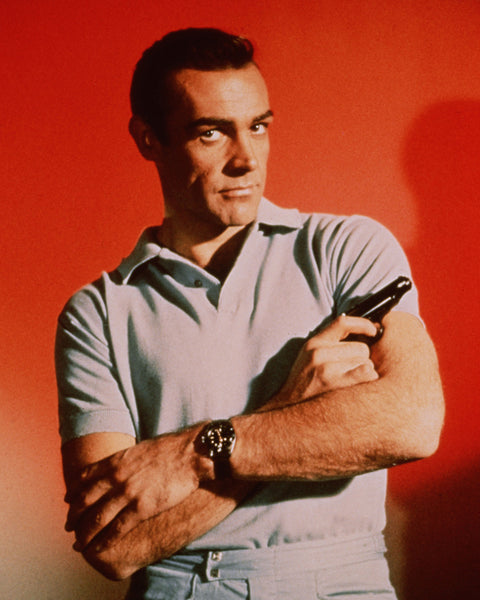The choice of brand and model with which to create our first wristwatch story was not a difficult decision, nor was the choice of writer to pen the opening article. Martin Skeet is the author of 'Vintage Rolex Sports Models' and helps dealers and collectors to authenticate and value vintage Rolex watches. He has been an Anthony Sinclair customer and friend of Mason & Sons since 2012.

Paul Newman wearing his Rolex Cosmograph Daytona
Introduction
Nicknames are ubiquitous in the watch trade. Created by dealers to easily identify and separate slightly different versions of watches, they have become a kind of horological slang for those in the know. Whilst some of the nicknames are a little arcane: a particular version of the Submariner is known as the ‘Bart Simpson’ because the Rolex crown on the dial looks a bit like the cartoon boy’s hair. Many are straightforward: today watch dealers all over the world refer to all early Submariners without crown guards as ‘James Bond’ models, because they were worn by Sean Connery in the first Bond Films.

Sean Connery wearing a Rolex 'James Bond' Submariner
The ‘Paul Newman’ Cosmograph Daytona received its nickname because, from 1972 until his death in 2008, the movie actor Paul Newman was often photographed wearing a 1968 Rolex Daytona with a distinctive dial. What makes this nickname so special is that Mr Newman was both a Rolex owner and amateur sports car racer and he actually wore his Daytona when racing in the 24 Hours of Le Mans and Daytona races.

Paul Newman preparing to put the Daytona to work.
But let’s start at the beginning, why is ‘Daytona’ linked with Rolex?
At the beginning of last century the Florida city of Daytona started attracting motorsport enthusiasts to its wide beach of smooth, compacted sand, which was an ideal surface for land speed record attempts. From 1936, when the first stock car race was held on the Daytona Beach Road, Daytona steadily grew to become the world capital of speed.

William Kissam Vanderbilt II in his car, 'The White Ghost,' At Daytona Beach, Florida (c.1904).
At around the same time that Daytona held its first races, Rolex had started to build a strong reputation as a manufacturer of versatile sport watches and created its first chronograph wristwatch with a single push button on the side to start, stop and reset a separate second hand. Although not specifically designed for automobile racers, this watch was immediately purchased by those involved in motor sport.

Rolex Oyster Chronometre-Centregraph c.1939 sold at auction by Christie's
By 1955 Rolex had created a watch specifically designed for motor-sport applications. This was a manual-wind chronograph in an oyster case featuring a tachometer scale on the outer ring and a telemeter scale for distance measurement on the inner ring. It had three sub dials measuring elapsed time of up to 60 seconds, 30 minutes and 12 hours. This was the reference 6234 and was the precursor to the ‘Daytona’ model we know today.

Rolex Oyster Chronograph 6234 (c.1959) recently sold at auction by Phillips
At first the watch was advertised using the name ‘Le Mans’, another famous home of speed, before finally adopting the name ‘Daytona’ after the now legendary race-track.

Early advertisement for the Rolex 'Le Mans' Chronograph
The Rolex Cosmograph Daytona ‘Paul Newman’ in detail
By 1963 the name ‘Daytona’ was actually printed onto the dial of Cosmographs and in the same year Rolex introduced a version with a newly styled dial known as the ‘Exotic‘ dial. Mr Newman’s own 1968 Rolex Daytona, reference 6239, with an exotic dial was a gift from his wife Joanne Woodward.

If your wife is looking for gift ideas.
He obviously liked it, but the exotic dial is unusual and not to everyone’s taste – more on that later. The numerals are in a ‘semi-serif’ font rather than the standard sans-serif, and running around the edge of the dial is an outer track in a band of colour – either black or white. The sub-dials feature a cross-hair design and the smaller sub-dial lines terminate in a square block of colour. The seconds sub-dial placed at the 9 o'clock position is also different from the standard dial and is marked 15, 30, 45 and 60, instead of being marked 20, 40 and 60.

Newman's Own - Rolex Daytona reference 6239
The ‘Exotic’ dial’s quirky design meant that these versions sold in far fewer numbers than the standard dial. It was not uncommon for a watch dealer to replace the ‘Exotic’ dial with a standard version to make a sale – just one of the reasons these watches are so scarce and collectible today.

Joanne's gift was delivered with strict instructions.
Just like the standard dials, the ‘Exotic’ dials were available in white or black with sub-dials in contrast. Interestingly, the white dial versions with black sub dials have a further nickname all of their own and are known as ‘Panda’ dials due to an apparent similarity to the markings on a panda’s face.
Rolex Daytona 'Exotic' Dial in Black available to buy here.
Many further versions of the Rolex Cosmograph Daytona followed with a myriad of small changes to the dials and movements but today a Rolex Cosmograph Daytona ‘Paul Newman’ is generally recognised by collectors as an ‘Exotic’ dialled version of the 6239, 6241, 6262, 6263, 6264 or 6265 references.

The perfect timepiece - on or off the track.
Today, these highly collectible watches command strong prices, but most examples available seem a bargain compared with Mr Newman’s own original Daytona watch, which sold at Phillips auction house New York in October 2017 for a staggering sum of $15.5 million. It took just minutes of bidding, before the watch was sold to a telephone bidder who not only paid the highest price yet achieved for the sale of a wristwatch but also cemented the Rolex Cosmograph Daytona ‘Paul Newman’ as the pinnacle of vintage Rolex collecting.


